By Carlo Platella
The veils fall on the Aston Martin AMR24, defined by its creators as “a strong evolution” of the already surprising 2023 car. At Silverstone there was no need for any revolution, with the awareness that part of the AMR23's shortcomings lay in the set-up and track management, aspects perfected to extract more load from the surface. Even more than finding a new performance compared to the end of last championship, the priority was to build a solid platformwhich can be developed continuously to acquire further competitiveness during the year.
A basis for development
“The main goal is to make sure this car is a good platform to bring updates to throughout the season.” Technical director Dan Fallows immediately clarifies what line of thought guided the development of the AMR24. The objective is the result of the experiences of 2023, when the updates designed to increase load and efficiency ended up altering the aerodynamic characteristics of the car, narrowing its operating window and making its driving style less intuitive. Like other teams, Aston Martin has had to mature a better understanding of the physics of ground effectwhich places emphasis on aerodynamic aspects that were negligible with the previous generation of cars.
Even before the new aerodynamic surfaces, the progress derives above all from the more effective mechanical development of the car. The fund's performance, in fact, is highly sensitive to height, posture and movements relative to the ground. Fallows explains: “Last year we learned a lot, also from an operational point of view, how we approach various aspects, including the introduction of new features on the machine. There is always a certain risk in developing a car: you have to find compromises that you can live with. We have learned a lot about these regulations and how the car must work to extract the best from the aerodynamics”.
The objective of being able to count on a platform less sensitive to aerodynamic innovations seems to have been achieved: “We have a stable foundation on which to introduce updates and continue to improve performance.” Being able to make changes to the car will be crucial in 2024, after the last race of 2023 saw 18 drivers enclosed within 6 tenths of a second, as Alonso points out: “With a small upgrade, from one race to the next you could leap from Q2 to the podium. It will be a very interesting season, both on and off the track, to bring developments that can make a difference.”
New Mercedes suspension
The AMR24 was created around a new chassis, with the aim of widening the operating window, aiming to be competitive on every type of track. Straight line speed was one of the weak points of 2023, which is why it is worked a lot on aerodynamic efficiency, understood as the relationship between load and forward resistance. Another priority was the consolidation of the aerodynamic map, trying to extract more load in high-speed corners, conditions in which the car travels close to the ground and with reduced yaw angles. All without giving up the strong points of the AMR23, including traction when exiting slow corners and tire management.
The material released for the launch mainly includes digitized images, which however correspond to the photographs received from the shakedown at Silverstone. The front suspension strongly follows that of 2023, maintaining the push-rod scheme, with the steering arm aligned with the lower triangle. The strong anti-pitching kinematics seen in 2023 returns, with a height difference between the two upper arms (1), useful for stabilizing the rotations of the floor during braking, generating load with greater consistency and predictability.
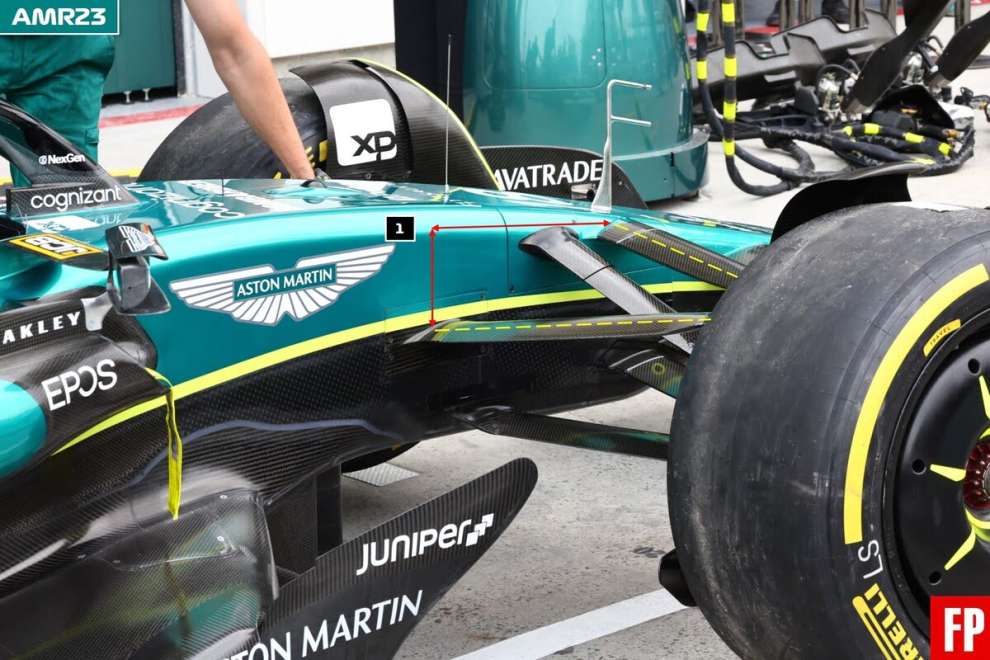
At the rear Aston Martin inherits the new Mercedes suspension, thus revealing the design choices of the Brackley team, also shared with Williams. The scheme switches from the 2023 pull-rod to the push-rod (2), activating the shock absorber spring assembly in the upper part of the rear structure. The push-rod scheme adapts better to the bodywork with flat sides, freeing up space in the lower part and favoring the circulation of the flows conveyed by the sides. The images of the track confirm this a decidedly extreme scheme for Aston Martin/Mercedes, with a very high and almost lying strut to favor local aerodynamics, but which certainly does not relieve the mechanics of stress.
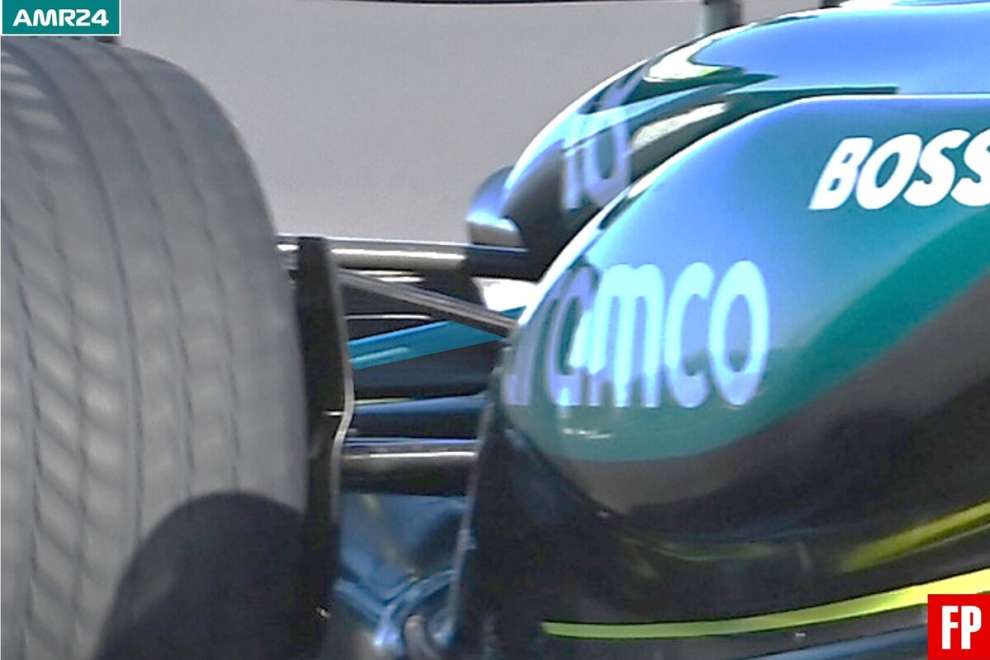
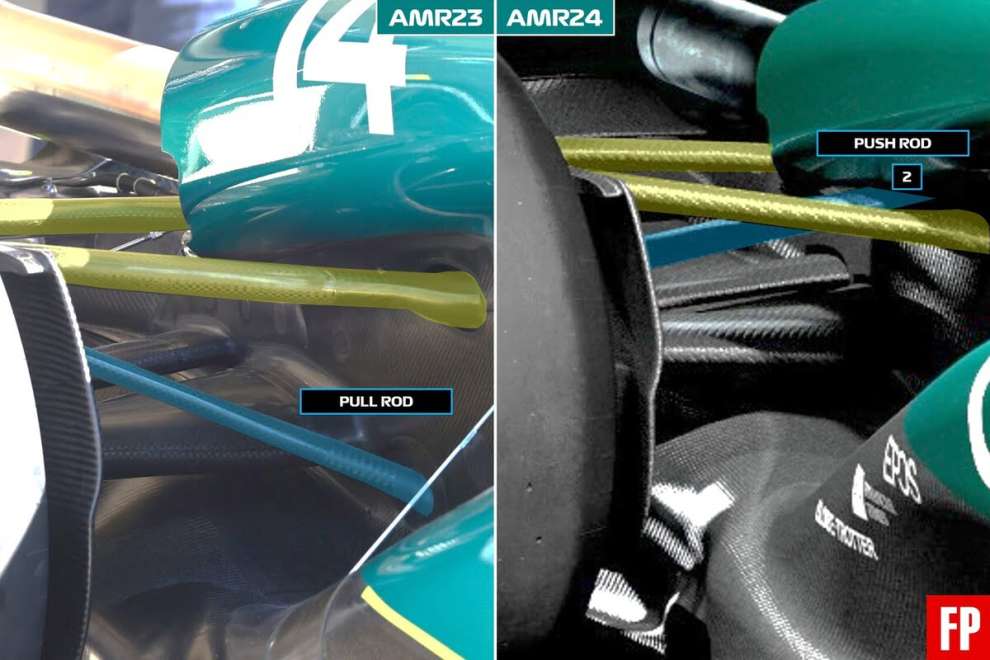
Front wing
The aerodynamic innovations on the AMR24 already stand out at the front, where a new wing appears. The profile trend is optimized but not distorted compared to 2023, just as the distribution between the fixed and adjustable sections of the flaps is similar. The most obvious change is interesting the nose (3), which now stops at the penultimate element, freeing a space between the two lower profiles through which to blow air under the car.
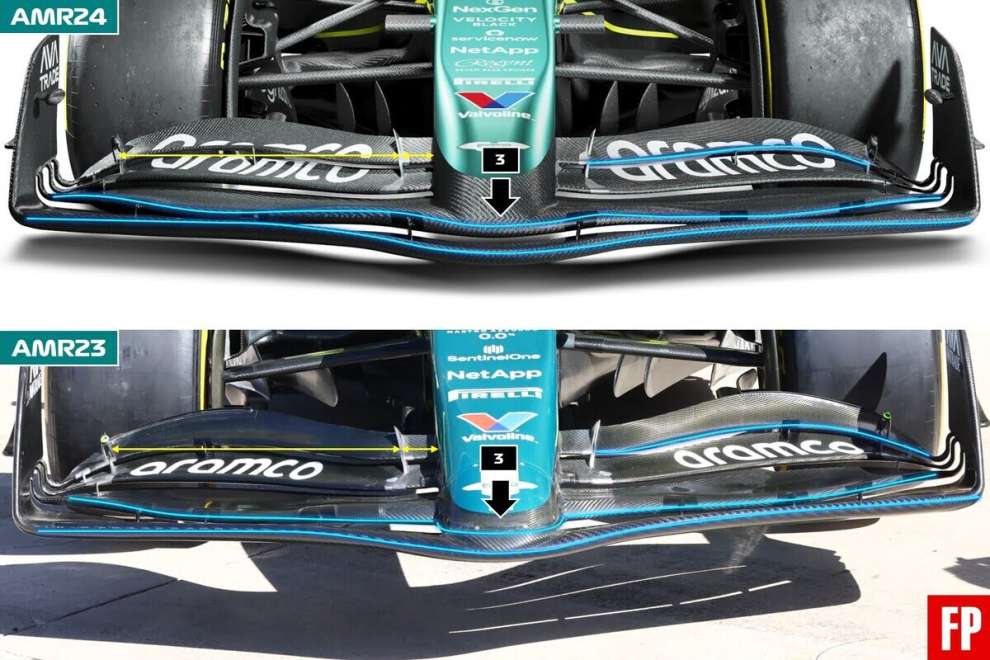
Hidden news
Dan Fallows also mentions important innovations under the bodywork. Although invisible from the outside, it is reasonable to assume that Aston Martin has optimized the packaging of the components inside the bonnet, freeing up volumes to draw bellies with more aggressive forms. The internal bodywork has also changed. Improving the circulation of cooling flows allows for optimized temperature management, accompanied by a reduction in cooling drag, the resistance associated with the cooling work.
The work on internal aerodynamics shines throughthinning of the side air intakes (4). Continuing the trend of recent seasons, Aston Martin is increasing theaspect ratio, squeezing and widening the lateral mouths. At the moment, the AMR24 features even more extreme air intakes than those seen on Red Bull in the second half of 2023.
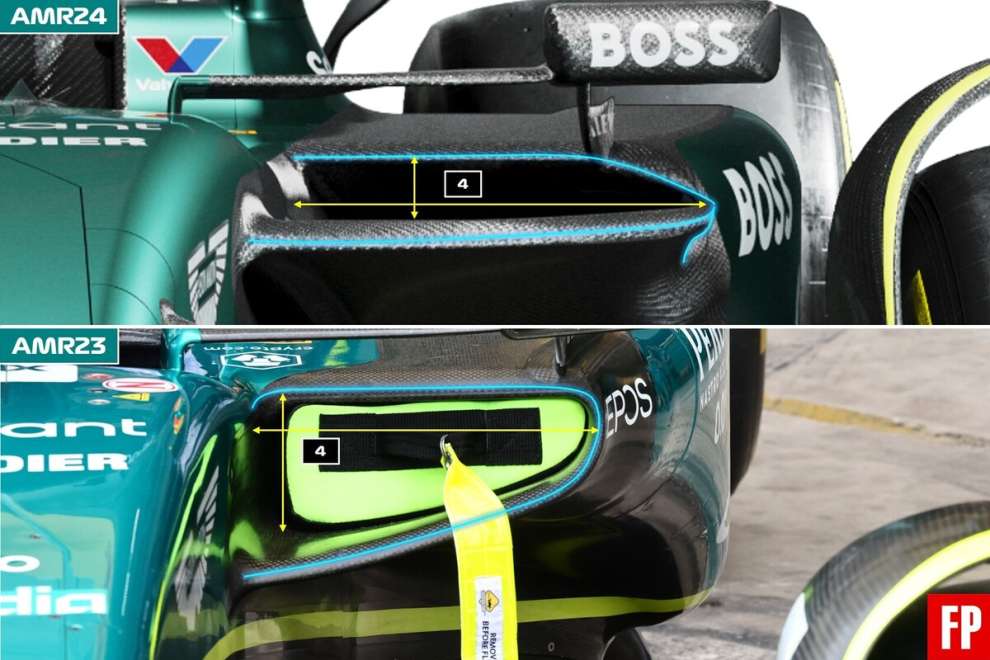
From the side you can also appreciate how much the lower lip of the cooling mouth extends forward (5). All this helps to channel the flows with better progressiveness under the sides, transporting energy up to the gearbox area, useful for powering the work of the diffuser. Squeezing the side holds also helps create a local area of high pressure on the sides of the cockpit, important for pushing turbulence outwards, away from the bottom.
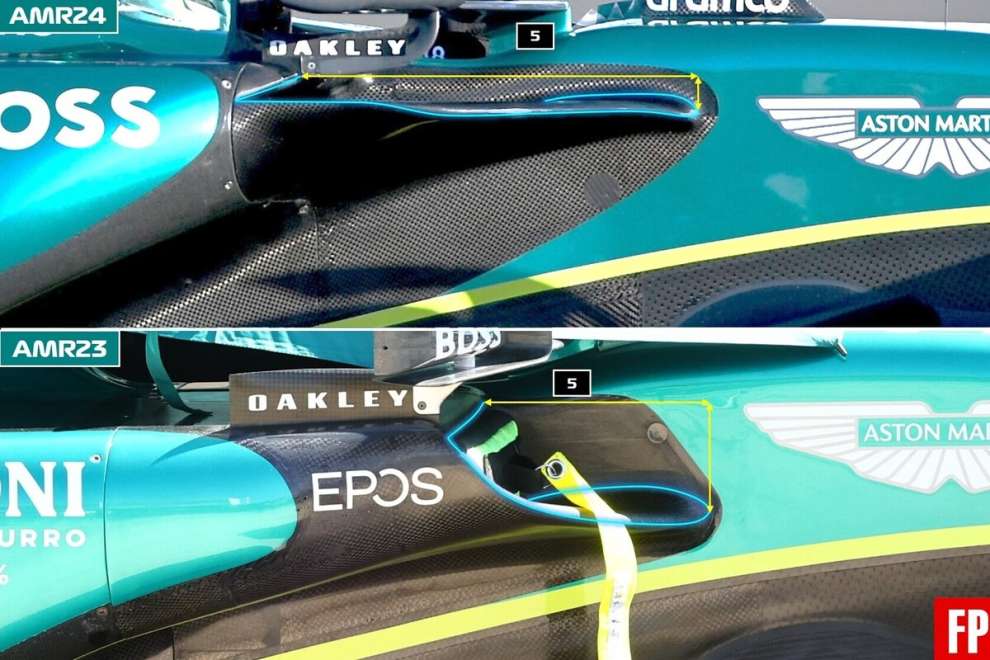
Car body
By broadening your gaze you can see how the crushing of the lateral outlets raises the flow channeling point under the sides (6). Overall, the bodywork carries on the belly-beating approachnow dominant on the grid.

From the aerial view, they are appreciated the deep channels dug into the upper part of the bellies, which had already characterized the AMR23. Unlike last season, the same channels now start further back and above all appear narrow (7). Finally, the three-quarter view highlights the different depth of the undercut, the canal that runs along the lower contour of the belly (8).
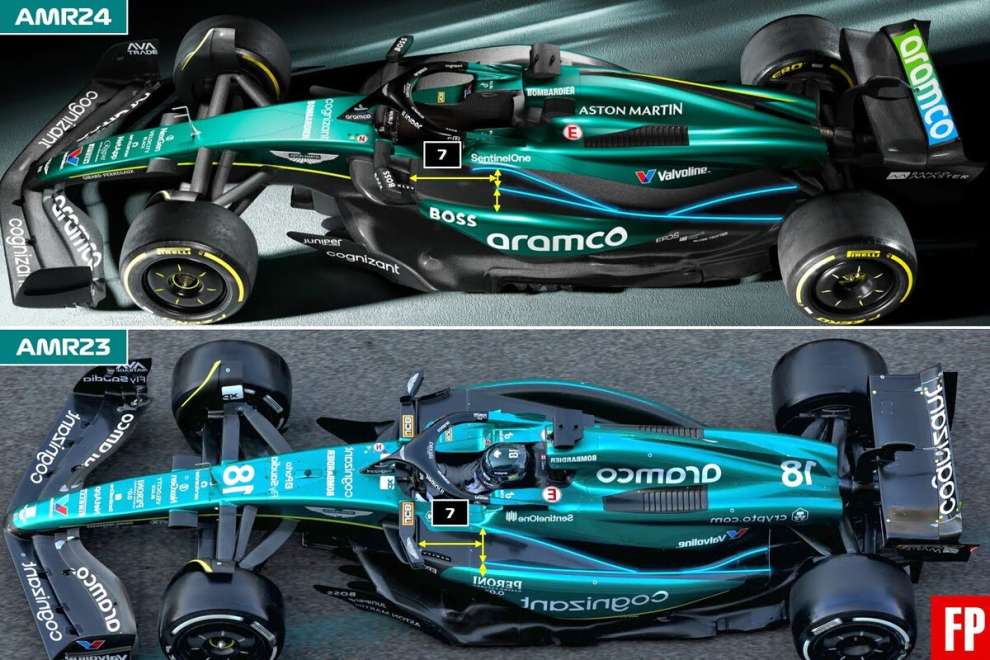
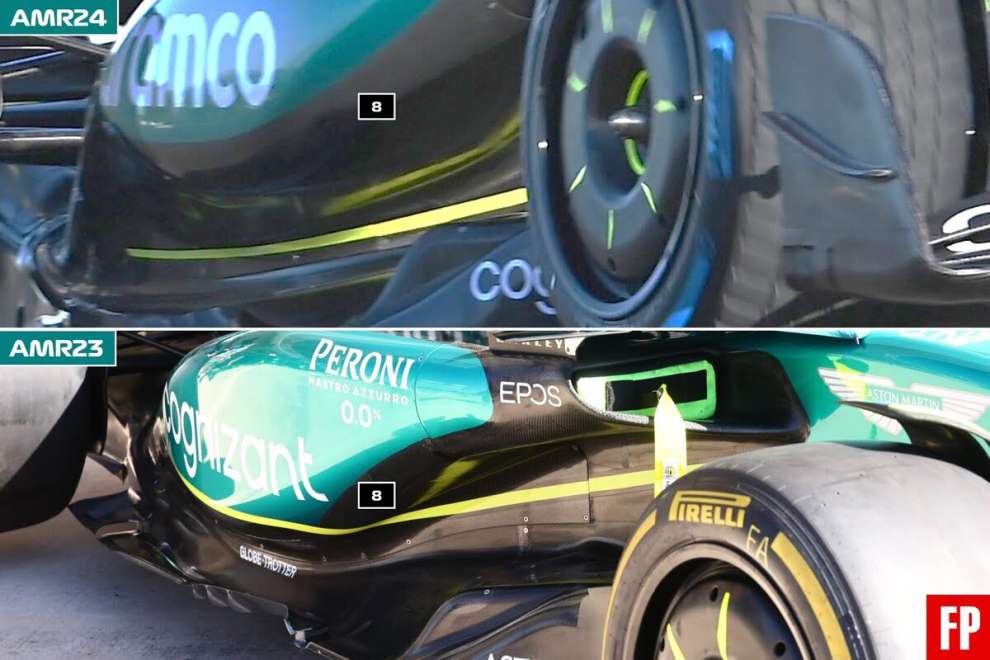
The bottom
The bellies, evolved but not distorted, interact with the aerodynamics of the surface. The external edge itself, noticeable in the photographs from Silverstone, continues the evolution undertaken with updates at the end of 2023 (9). This is a delicate area for drawing air laterally to the bottom, accelerating bottom flows, generating load and protecting it from external turbulence.
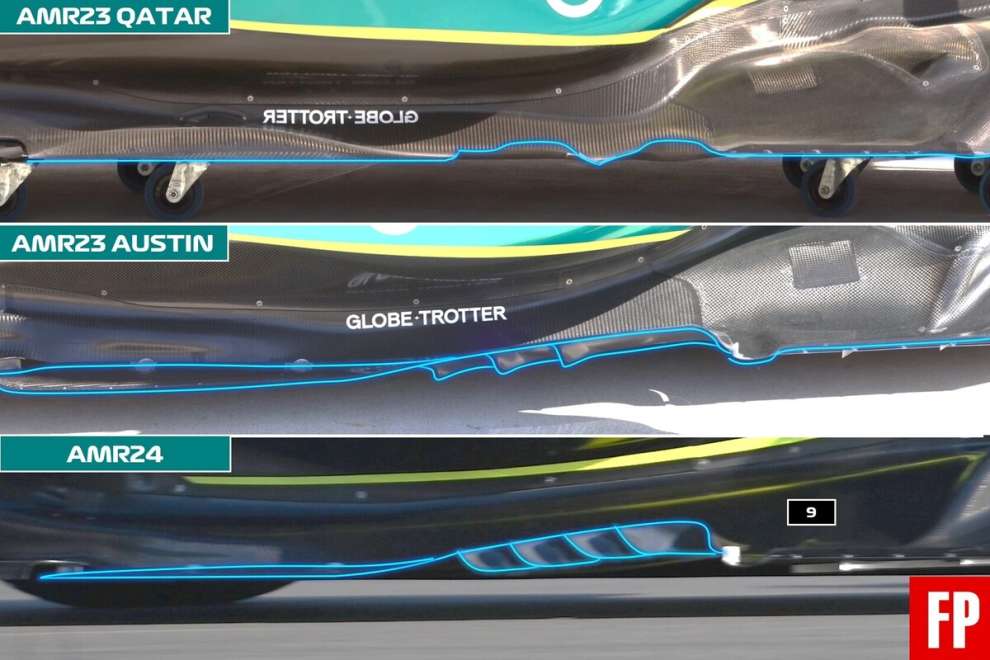
Even as regards the outermost strip to protect the Venturi channel, the specification at the beginning of 2024 is similar to that of the end of 2023 (10). “At the end of last season we were developing some relevant news for this year”, confirms Dan Fallows. The updates were actually partially removed after a couple of Grands Prix, but they still proved invaluable in gathering useful information for the 2024 car. “Towards the end of the season we took a pragmatic approach. We wanted to take every opportunity to learn everything we needed to know about the AMR23. In some races we actually conducted test sessions.”
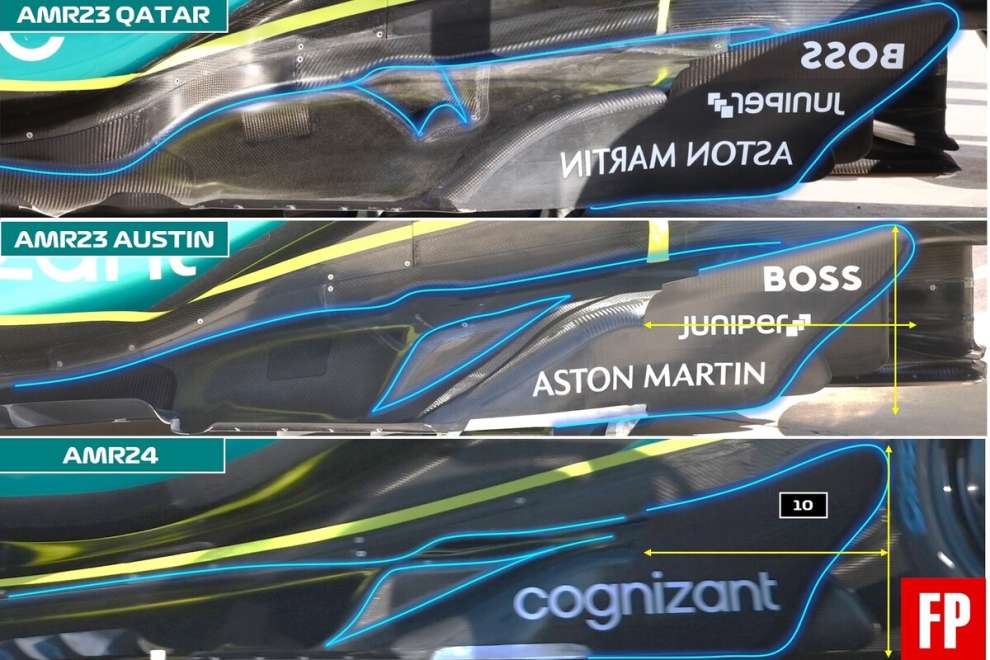
The progress
In the last qualifying of 2023 in Abu Dhabi, the best of the Aston Martins qualified 3 tenths behind McLaren. Commenting on the progress made since then, Lance Stroll quantifies the expected leap with the AMR24: “We recovered 3 tenths and found 3 more”. So six tenths overall earned from the end of 2023, numbers that always need to be put into context, as they vary depending on the tracks and above all between the qualifying and race scenarios. More importantly, the simulator is able to estimate the absolute gain in terms of performance, but the relative recovery over opponents will depend on how much the competition has grown as well.
#Aston #Martin #technical #analysis #features #worth #tenths